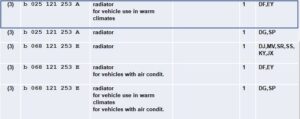Following on from several recent discussions with both trade and retail customers who have approached us regarding the supply of radiators for the T3 either as a standard replacement or an uprated version we’ve been prompted to write this post regarding whats happened with the radiators over the last few years and what’s available now and to dispel some of the myths flaoting around.
As far as VW are concerned, and ignoring the very early Diesel radiator which isn’t available anyway… and the “DF” radiator which isn’t either, there are 2 different radiators. a version with a 34mm core or the bigger version with a 42mm core..
This measurement refers to the thickness of the radiator core. The core being the “finned” section of the radiator that has channels that the coolant runs through.
Actually it’s more complicated than that, as there are a number of dropped part numbers (including one that was discontinued before the watercooled models were even made… but we’ll ignore all those too as they all supercede to the same parts.)
We’ve recently seen enquiries about a radiator with a 50mm core, supposedly fitted to vehicles for “hot climates”.
This didn’t make sense to us, as the “hot climate” radiator is the 42mm core radiator, as factory fitted to the 2.1i and Turbo Diesel models.
There is another “hot climate” option, which is listed for the “DF” engine and which is in fact the standard 34mm radiator, so a “hot climate” radiator for a DF would be the standard radiator for the 1.9 “DG” for example. A “hot climate” radiator for the “DG” would be a radiator as fitted to the 2.1 and TD models. There is, as far as we can tell, no “hot climate” radiator for the 2.1 and TD. They all had the same 42mm core radiator.
Going back to this mythical “50mm core”, we believe this is either a misunderstanding of how radiator cores are measured (they have measured the top/bottom plate rather than the core itself) or in some cases a little intentional deception to help boost sales… pointless really as any schoolgirl with a ruler can confirm the core thickness.


Previously, we have offered 2 options for the larger 42mm core radiator, an original South African produced radiator from Hella (still made until a couple of years ago), which was pretty much exactly the same as the one VW fitted in the factory, and an alternative which is an aftermarket radiator sold under many different brands. Sadly the originals are no longer available, part of the reason for this is the insistance by some suppliers that the cheaper rads are the same as the originals resulting in a drop in demand for them. Some of those suppliers now claiming to supply some special “50mm core” radiator (which actually has a 42mm core).

Please review the following table that lists all the different radiator part numbers as fitted to a T3, when they were discontinued and which part number they were replaced by.
| VW No | Style | To fit | Core | Construction | Discontinued by VW | Superseded to | Notes |
| 025 121 253 | Late | 1.9l DF and EY | 34mm | Plastic tanks | 01/06/12 | NLA | Just use 025 121 253 A Instead |
| 025 121 253 A | Late | 1.9l DG | 34mm | Plastic tanks | 01/02/12 | NLA | Upgrade for DF & EY |
| 068 121 253 | Early | 1.6D CS | 35mm | Metal tanks | 30/09/80 | 068 121 253 A | Dropped before introduction! |
| 068 121 253 A | Early | 1.6D CS | 35mm | Metal tanks | 01/12/02 | NLA | Repair or Convert to late style. |
| 068 121 253 B | Early | 1.6D CS | 35mm | Metal tanks | 31/01/83 | 068 121 253 A | |
| 068 121 253 C | Late | All except DF, DG, EY & SP | 42mm | Plastic tanks | 15/05/87 | 068 121 253 E | |
| 068 121 253 D | Late | All except DF, DG, EY & SP | 42mm | Plastic tanks | 30/09/94 | 068 121 253 E | |
| 068 121 253 E | Late | All except DF, DG, EY & SP | 42mm | Plastic tanks | 01/10/09 | NLA | Upgrade for DG/SP in Hot Climates |
The parts in bold are radiators that we currently stock.
The early or late style in the table above refers to the radiator style and not the vehicle, early style radiators were only ever fitted to 1.6D “CS” engines and were of a more traditional construction having brass tanks and a soldered core. The early radiator is easily identified by it’s huge design flaw by having the cooling fan switches at the top of the left hand tank, any loss of coolant would render the fan switches inoperable and would accelerate a oveheat situation.
Luckily, VW realised the shortcomings in this early style radiator design and it was replaced with the introduction of the WBX engine for the 1983 model year by the later style radiator with plastic tanks, aluminium core and a fan switch in a sensible place!
Hopefully this page clears up some of the misinformation floating around and helps you make an informed choice when shopping around for a radiator.
Just measure the core on your “specially produced” radiator and check you’ve got that extra “girth” you’ve paid for.
As with all this kind of stuff, you pays your money you takes your choice.
